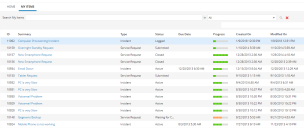Service Manager
This is the latest version of the help for Ivanti Service Manager 2018. If you cannot find some of the features described in the help, you may be using an older version of the application. To upgrade the application, click here.To view the help for the latest version of Service Manager, click here
About the My Items Workspace
•Adding Parent Business Objects to My Items
About the My Items Workspace
The My Items workspace is a way for users in the Self-Service Portal to track their service requests and issues. They can access their list of items from their home page in the My Open Items pane, or from the My Items workspace.
Administrators can view a list of all My Items for all users, and see the progress of each at a glance.
My Items Workspace
Viewing My Items
1.Log into the
2.Open the My Items workspace. A list of items appears.
3.Click a title from the list to view details.
Filtering the My Items List
The My Items workspace
1.Log into the
2.Open the My Items workspace. A list of items appears.
3.In the toolbar area, enter a term or string into the first search text box.
Adding Parent Business Objects to My Items
By default, the My Items table in the Self-Service Portal is configured to show incident, service request, and approval records, but you can add other business object records.
1.From the Configuration Console, click Build > Business Objects to open the Business Objects workspace.
2.Open the My Item business object. The object details page appears.
3.From the Object Fields tab, choose ParentObjectType. The details page appears.
4.In the Pick List area, click values. The system displays the list of parent business objects.
5.Click Add. The New My Item Object Type window appears.
6.Enter the business object type to add.
7.Click Save. The window closes and the new object appears on the list.
8.Add translation text. Click (not set) and enter the translated text.
9.Click Close. The window closes and the value is automatically saved.
10.Inspect the status object to ensure the new object statuses have been included. See Adding a Status to My Items.
11.You can create form offerings using this object. See Creating a Form Offering.
Adding a Status to My Items
By default, the My Items table in Self Service is configured to show incident, service request, and approval records. The values for the MyItem status business object contains statuses from the incident, service request, and approval business objects.
When adding a custom status to any of these business objects, you must also add it to the My Item (FRS_MyItem) business object field for it to appear.
Method 1: Using the My Item Status Workspace in the Service Desk Console
1.Log into the Service Desk Console.
2.Open the My Item Status workspace. The list of items appears.
3.From the toolbar, click New My Item Status. The system displays a blank form.
4.Enter the new status into the text box.
5.Click Save. The status appears on the list.
Method 2: Using the My Item Business Object in the Configuration Console
1.From the Configuration Console, click Build > Business Objects to open the Business Objects workspace.
2.Open the My Item business object.
3.From the Object Fields tab, choose Status. The system displays the Status Details page.
4.In the Pick List area, click values. The system displays a list of statuses. Notice that default statuses from incident, service request, and approval are also included.
5.Click Add. The system displays the New Status window.
6.In the Status field, click Add, then add the new status such as waiting. To enter a localized value for the new status in any of the available locales, enter the value in the appropriate column.
7.Click Save to close the window, then click Close.
8.Click Save.
Was this article useful?
The topic was:
Inaccurate
Incomplete
Not what I expected
Other
Copyright © 2018, Ivanti. All rights reserved.


